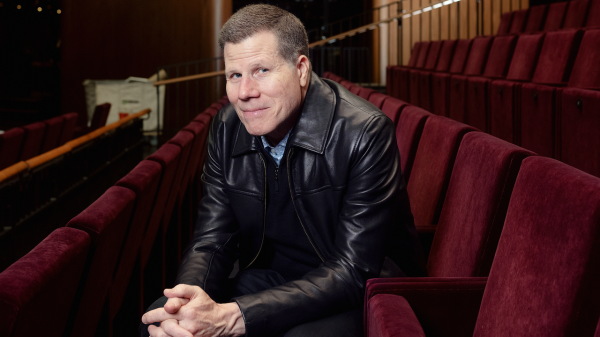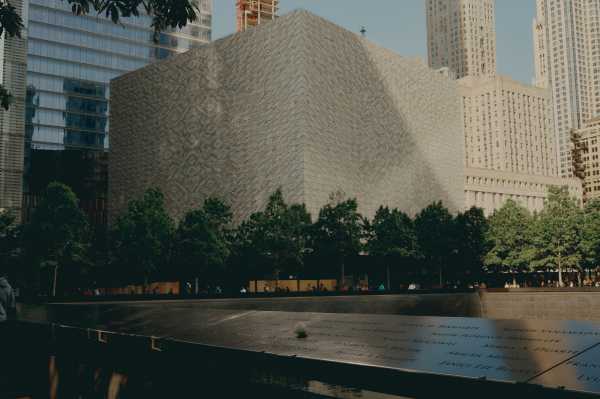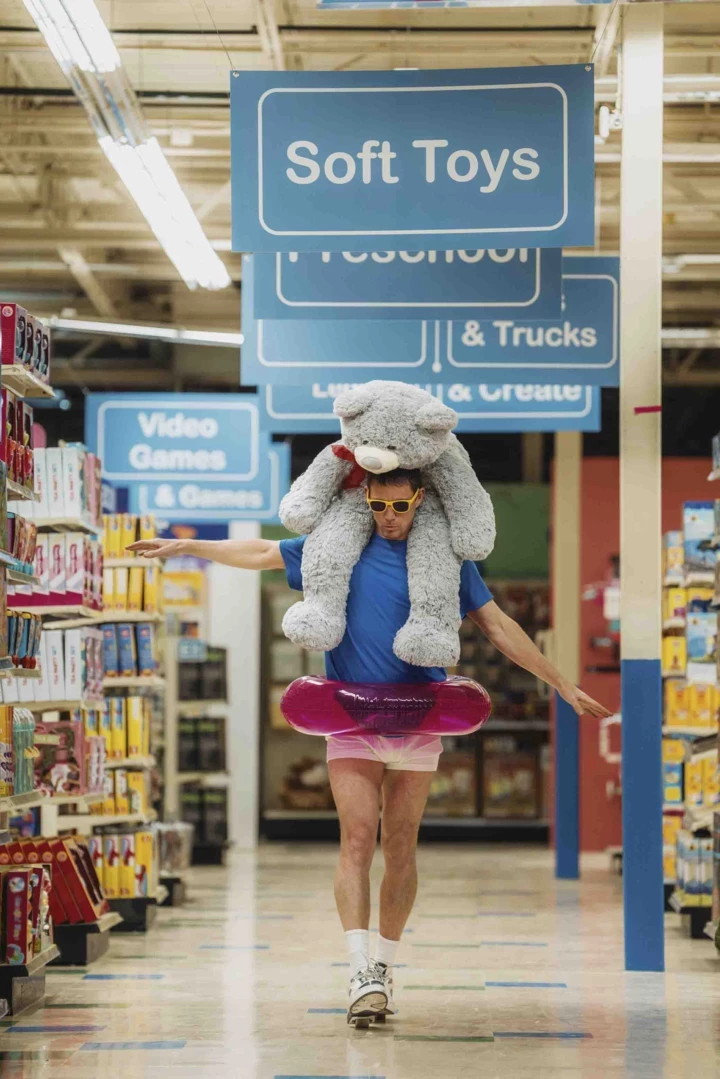
Save this storySave this storySave this storySave this story
Bill Rauch became obsessed with the survival of theatre as an undergraduate at Harvard, in the early nineteen-eighties. He’d already decided that he wanted to be a stage director, and was spending much of his time putting on plays wherever he could: the basement of his dorm, the freshman dining hall, in a Volkswagen bug on the street that leads to Harvard Yard. Then he heard a professor describe theatre as “a dead art form” and assert an alarming statistic: just two per cent of Americans, apparently, were regularly going to the theatre. Rauch had been told that the three pinnacles of theatre as a popular art in the Western world were Greek tragedy, English Renaissance drama, and American musicals. As a senior, he founded his own theatre company, and mapped out a mashup of “Medea,” “Macbeth,” and “Cinderella”—one exemplar of each style—so that they could be performed simultaneously. It was a way of seeing what they had in common, and how theatre could return to its populist roots.
After he graduated, Rauch and a college friend, Alison Carey, concocted another plan for attracting people to the stage. Funding from the Virginia Commission for the Arts allowed them to teach workshops by day and direct community theatre at night, starting with “Our Town” in Newport News. After that production was over, Rauch, Carey and their friends, calling themselves the Cornerstone Theater Company, drove to North Dakota, where they recruited locals to put on “Hamlet” in an old vaudeville theatre. At one point, Carey took over pouring drinks in a bar so that the owners could perform. The locals they recruited worried that Shakespeare’s language was too arcane, so the company modernized it, converting “arrant knave” to “downright prick,” for instance. (They ultimately changed that one: “downright prick,” they were told, was something “smart-ass college kids” would say. A rancher suggested “horse’s rear,” and that went into the script instead.)
They repeated the process in months-long stays across the country, adapting classic plays to speak directly to the communities where they had set up shop. Rauch directed, Carey and others tailored the scripts, and another classmate, Christopher Liam Moore—now Rauch’s husband—often played leading roles, opposite nonprofessionals who lived nearby. In Miami Beach, they adapted W. H. Auden and Christopher Isherwood’s “The Dog Beneath the Skin” to address the AIDS crisis. In Port Gibson, a Mississippi town riven by racial segregation, they staged “Romeo and Juliet” with an integrated cast. In 1992, they moved to Los Angeles, where they continued to stage site-specific plays exploring timely subjects in collaboration with locals. “What Bill did with Cornerstone was a radical revolution in the model of the American theatre,” Diane Paulus, the artistic director of American Repertory Theatre, told me. “He’s been the leader in the field. Everyone looks to Bill.”
Rauch stayed in L.A. for fifteen years. He left in 2007 to become the artistic director of the Oregon Shakespeare Festival, one of the country’s oldest and largest repertory-theatre companies, in Ashland, a small town just north of the California border. Rauch promised to expand its repertoire to include non-Western classics and to diversify both the company and the staff. He also announced a project called American Revolutions: The United States History Cycle—thirty-seven new plays to be written by a diverse group of playwrights and loosely modelled on the scope of Shakespeare’s collected works. Within a decade, actors of color made up around seventy per cent of the company, and they were putting on adaptations of Indian, Chinese, and Latin American classics alongside their Shakespeare productions. Meanwhile, American Revolutions, overseen by Alison Carey, achieved wide renown. “All the Way,” written by Robert Schenkkan about Lyndon B. Johnson, transferred to Broadway, and won the Tony for Best Play. “Indecent,” Paula Vogel’s queer history of Yiddish theatre, became one of the most produced plays in the country. Lynn Nottage’s factory tragedy, “Sweat,” moved to the Public Theatre, in New York, and won the Pulitzer Prize. The head of the Public, Oskar Eustis, called Rauch “an astonishingly successful regional artistic director, the most impactful of my generation.”
Then, six years ago, Rauch decided to attempt something even more complicated, perhaps, than the cross-country community-theatre productions of his Cornerstone days or the history-spanning commissions at O.S.F. He accepted a position as the inaugural artistic director of the Perelman Performing Arts Center, now mostly referred to as PAC NYC, at the World Trade Center, just across from the 9/11 Memorial and Museum.
The idea to include an arts institution near the museum—a hub for creativity and hope alongside the memory of devastation—emerged soon after September 11th, but, for years, it wasn’t clear what shape such an institution might take. A plan for an International Freedom Center was criticized as insufficiently patriotic; that proposal, which also included a drawing center, a dance space, and a resident theatre, was ultimately abandoned. The project got new life when the investor Ronald Perelman donated seventy-five million dollars, but it wasn’t enough; Michael Bloomberg ultimately contributed almost twice as much. Bloomberg also took over as chairman of the organization’s board, a position previously held by Barbra Streisand. Finally, this past fall, PAC NYC opened to the public in a gleaming five-hundred-million-dollar marble-clad cube perched above the memorial pools.
Although plenty of tourists visit the memorial and the museum by day, the financial district empties out at night; it’s hardly known as an arts destination. And, nationwide, audiences have been slow to return to live performance after the pandemic. Rauch, whom one playwright described to me as “the nicest man in show business,” told me that he sees his new position as a kind of third act, in which he will try “to bring the audience-focussed work of Cornerstone together with the scale of O.S.F.” But he’s still haunted by that statistic he heard in college, not to mention the new headwinds that theatre is facing now. “The question is,” he said, “who’s experiencing the work?”
I visited Rauch in Ashland about a year after he’d accepted the New York job. Behind his desk was a giant red photograph featuring one word in capital letters: “YES.” He’d bought it from an actor in his first days at O.S.F. “You can imagine how much I set myself up for anyone who wants to be cynical about me or my leadership,” he said. Trim, with neatly combed graying hair, Rauch has a broad face and eyes that crinkle shut when he smiles, which is often. O.S.F.’s former literary director, Lue Douthit, has described the time she advocated that the festival hire three dozen playwrights to translate Shakespeare’s plays into modern English verse. Rauch quickly approved the proposal, she explained, before correcting herself: “Actually, he said, ‘Hmm, interesting,’ which I translated to ‘yes.’ ” This year, O.S.F. will put on its first production from these commissions, Sean San José’s “Coriolanus.”
When I visited, Rauch, in his last season at the festival, was directing a new play, “Mother Road,” by Octavio Solis—a response to “The Grapes of Wrath,” imagining a Mexican descendant of the central family in Steinbeck’s novel. The play’s cast was simultaneously starring in “La Comedia of Errors,” a bilingual adaptation of the Shakespeare farce that grappled with immigration politics. Rauch, working with a modernization of Shakespeare’s text by the playwright Christina Anderson, partnered with the theatre artist Lydia G. Garcia to craft a Spanish-English version. “Bill surrounds himself with extremely bright and competent people of color who work to hold him accountable,” Darleen Ortega, a judge on the Oregon Court of Appeals, whom Rauch recruited to serve on O.S.F.’s board, told me. The ninety-minute production was designed to travel to non-theatre locations—a library, a hospital, a community center—in southern Oregon, where there is a large Spanish-speaking population.
At a rehearsal for “La Comedia,” Rauch arrived in a bike helmet, wearing a blue fleece and jeans. “Hello, friends!” he beamed. He greeted me with a warm hug, as he seems to do to everyone. “It feels like Cornerstone again,” he said. “Adapting a classic, a bilingual script, going on the road.” As the actors took out their scripts, he asked, “Who’s excited for the van?”
Both Robert Schenkkan and Bryan Cranston, who won a Tony for playing Lyndon B. Johnson in Rauch’s production of “All the Way,” said that for all his obvious warmth Rauch could also be tough. Cranston related Rauch’s firing of an actor who wasn’t working out during the play’s out-of-town run in Cambridge. “If you sense something going sideways, you have to make a move, and he made the move,” Cranston said. “He’s not afraid.” Still, for others, including the playwright Sarah Ruhl, Rauch “is a model of a leader who leads with kindness, who leads with gentleness,” as Ruhl put it. (She described Rauch holding her infant daughter during rehearsals of her play “The Clean House,” which Rauch directed at Lincoln Center, so that she could jot down notes.) In interviews, Rauch was so solicitous of what was going on in my life that I often found it hard to turn the conversation back to him. “The joke about Bill was that anyone who happened to walk by, he would ask them their opinion,” a designer at Cornerstone, Lynn Jeffries, told me.
That solicitousness seems of a piece with Rauch’s concern that theatre be inclusive and popular, that it speak to a wide range of people. The production that most successfully embodied this ethos at O.S.F. was probably, of all things, “Oklahoma!” For the musical’s seventy-fifth anniversary, in 2018, Rauch requested permission from the Rodgers & Hammerstein estate to make the leading couples same-sex, interracial pairs. It was a dream he’d nursed ever since being cast in a school production and wishing that his experience could be reflected in the show. Naysayers had told him that the estate would never approve such casting, and also that audiences in southern Oregon wouldn’t accept it. But the approval came, and, although some patrons did cancel their memberships—Rauch was accused of pushing a “gay agenda”—the production was a hit.
“Every production of his I’ve ever seen, on the face of it, maybe sounds like it’s a bad idea,” James Bundy, a fellow-director and the dean of Yale’s drama school, told me. But audiences, Bundy said, left that show in “a flood of emotion and joy.” He added, “ ‘Oklahoma!’ is the original chestnut, right? And he cracked the chestnut open.”
O.S.F. is known as a destination theatre. Ashland is a more than four-hour drive to any large city, and patrons who don’t live nearby need to have the means, leisure, and inclination to travel there. Many do: upward of four hundred thousand tickets were sold per season before the pandemic. But, while Rauch succeeded in expanding the diversity of the stories on the O.S.F. stage and the artists whose works were represented, his efforts to diversify the audience, by his own admission, couldn’t keep pace. “I love every single member of our audience individually,” he said in a published conversation with his successor at O.S.F., Nataki Garrett, the first Black woman to lead the festival. “But the fact is, in terms of racial diversity and socioeconomic diversity of our audience, we have not moved the needle as dramatically as I would have hoped.” Rauch told me that, when Cornerstone performed a commission by Lisa Loomer, in 1999, the demographics of the audience matched the racial makeup of Los Angeles County. He hoped that, in New York, he could make that happen again.

PAC NYC opened to the public, this past fall, in a gleaming five-hundred-million-dollar marble-clad cube.Photograph by Victor Llorente
On a sunny September afternoon in 2022, I joined Rauch at PAC NYC, then still under construction, where he was giving a tour to a delegation of arts administrators from the Los Angeles Philharmonic. Rauch, in a plaid shirt tucked into bluejeans, handed out hard hats and safety vests, then led us across a gravel expanse, past a row of portable toilets, and into a large freight elevator, operated by a man in a sweatshirt and work boots. “This is my friend Kevin,” he said. Kevin smiled.
As a teen-ager, Rauch worked at a summer stock theatre in Westport, Connecticut. “They called me the playhouse beautifier,” he said. “I’d put on my overalls and scrape gum off the underside of the seats. Then, at night, I’d put on a three-piece suit and usher for the plays so I could watch them in the back.” His father was a marketing executive who moved the family nine times in Rauch’s first nineteen years, up and down the Eastern Seaboard. Theatre was a refuge. One night at Westport, he saw a production of Henrik Ibsen’s “The Master Builder.” Rauch remembers that when the play began, the stage was crammed with furniture; by the end, it was nearly empty. “I wanted to know who made that choice, and whether I could be that person,” he said.
At PAC, we stepped out of the elevator into a mess of plywood, power tools, and electrical cords, and Rauch guided us into a black box lined with walnut panels. The walls weren’t fixed: the building, which would house dance, music, opera, stand-up comedy, and film in addition to theatre, was designed for transformation. Its three performance areas can combine into one large arena, or divide in two; stages can be thrust into the audience or be surrounded by seats on all sides. There are more than sixty possible configurations. “That flexibility is key to our mission,” Rauch said. The transformable spaces also appealed to his puzzle-solving side. “He loves a complicated structure,” Lynn Jeffries told me. “People think of him as Emotional Bill: ‘Oh, he’s so warm and fuzzy, and he cries.’ But he calls it ‘math theatre.’ ”
Bloomberg, speaking with the Times, has suggested that the building could also adapt for commercial possibilities. “Lots of companies are going to want to rent this space,” Bloomberg said. “Weddings, bar mitzvahs, confirmations, graduations.” Being an artistic director is always a mix of idealism and pragmatism, articulating a vision and then figuring out the material necessities to make it happen. In a written statement, Bloomberg told me that Rauch had impressed the board with his “business savvy” and also “his experience starting and running cultural institutions.” In the current moment, as theatres of long standing all around the country close or curtail their seasons, that work may be as hard as it’s ever been. PAC is in the country’s largest city, and has significant financial support. Even so, to succeed, it may have to be many things to many people.
In the walkway outside the theatre, Rauch paused to look at the afternoon light streaming through the glass-encased marble shell. Below us were the hollow footprints of the Twin Towers. Inside the building, translucent squares of marble radiated amber and gold. “It’s a sacred space,” he said. We filed out past the lobby, which would be open to the public, with couches and a stage for free performances. “It’s lower Manhattan’s living room,” PAC’s executive director, Khady Kamara, told me.
PAC NYC officially opened its doors this past September. There was a special event for 9/11 families, then an opening celebration, then a concert series, on the theme of refuge. Outside the building, digital kiosks advertised upcoming shows, among them “Watch Night,” a multidisciplinary response to the shootings at Charleston’s Mother Emanuel A.M.E. Church and Pittsburgh’s Tree of Life synagogue, and “An American Soldier,” an opera about a Chinese American private who died in Afghanistan. “Between Two Knees,” a satirical history by the 1491s, a Native sketch-comedy troupe, will be staged in February. (It was first performed at O.S.F.) This summer, Rauch will make his own directing début in the new building, in a collaboration with Zhailon Levingston: a drag ballroom production of “Cats,” with Old Deuteronomy presiding over a runway competition at the Jellicle Ball. Another chestnut he’s hoping to crack open.
For the first installment of the concert series, “NYC Tapestry: Home as Refuge,” two of the flexible spaces were configured as an intimate six-hundred-seat box. The lights dimmed and black-clad performers from thingNY, an experimental chamber ensemble, lined up across the lip of the stage, singing interwoven lines—sometimes dissonant, sometimes aligned on words like “home,” “empire,” “arrive.” The piece was “Wave Upon Wave,” a new commission from the Navajo composer Raven Chacon, setting text by the Mojave poet Natalie Diaz. A curtain lifted, and there was a burst of sound from Mwenso & the Shakes, a band rooted in the traditions of the Black diaspora; the house lights came on, and Michael Mwenso, the group’s front man, asked us to write down, on note cards inside our programs, what home meant to us, and to pass the cards to the ushers. There was more: a haunting Arabic elegy sung by Emel, a virtuosic performance on a Chinese two-string fiddle by Wang Guowei, a monologue about safety from the perspective of a dog, delivered by Laurie Anderson, accompanying herself on electric violin. Angélique Kidjo, the Afro-pop diva from Benin, taught the audience the chorus to her hit with Kids United, “Mama Africa,” and the other musicians came out to join her. The crowd sang as their definitions of home were projected on a screen. Some people had written down abstract ideals; others had described family relationships. A few people had written down their addresses.
That upbeat inclusiveness was evident again two days later at a concert titled “Playing It Forward: School as Refuge.” The Israeli singer-songwriter David Broza divided the house into three parts and led everyone in a call-and-response number in English, Spanish, and Hebrew: “Not different,” “No diferente,” “Lo shonim.” We were asked to text the name of a favorite teacher to a special number; later, the rapper Common joined Arturo O’Farrill & the Afro Latin Jazz Orchestra onstage and concluded the night with a freestyle refrain, “I just wanna be PAC NYC,” as teachers’ names scrolled behind them. Afterward, in the lobby, Rauch greeted family and old friends from Cornerstone and Oregon. Amrita Ramanan, who had been the literary director at O.S.F. and now directs the new-works program at the Public Theatre, ran up to him. “It’s so pluralist! It’s so welcoming! It’s so you!” she said. “And the seats are so comfortable!”
The seats were comfortable, and I found the concerts engaging, but it’s not hard to imagine how an effort to appeal to everyone might lead to work that feels diffuse. In November, a reviewer for the Times complained that “Watch Night” lacked dramatic focus, despite its heavy-hitting topics, and that its use of the flexible seating configurations made portions of the production hard to see. Reviews in smaller outlets responded more favorably to that show, and also to “Is It Thursday Yet?,” a PAC NYC commission from choreographers Jenn Freeman and Sonya Tayeh exploring Freeman’s experience of autism-spectrum disorder. “Do I want to sell tickets and get good reviews?” Rauch asked me, rhetorically. “Sure. But what I really care about is whether the work makes an impact on the lives of the people who experience it.”
On my last day with him, Rauch was being shadowed by a Yale M.F.A. student, Roman Sanchez, who was doing a fellowship in theatre management. I asked him why he’d picked PAC NYC. “I wanted to go wherever Bill was at,” Sanchez said. “I’ve been a fan since the Cornerstone days, and seeing how he’d institutionalized community at O.S.F. I was curious how he’d institutionalize community at an organization like this, and what it means to build a culture, externally and internally.” Sanchez had been impressed by the work so far; PAC had partnered with local community organizations and invited families from around the city to visit the building for free performances. But Sanchez also spoke to the difficulty of what Rauch was attempting. “Amazing work happens at the grassroots level,” he said, “but how can an organization and people with positional sway and a multimillion-dollar budget do that without losing their values?” Sanchez thought for a moment. “I don’t know if it’s possible, but I think this is a really great example of someone—of an organization that is doing it.” “It’s trying, it’s trying,” Rauch said. “It’s our aspiration.” ♦
Sourse: newyorker.com







